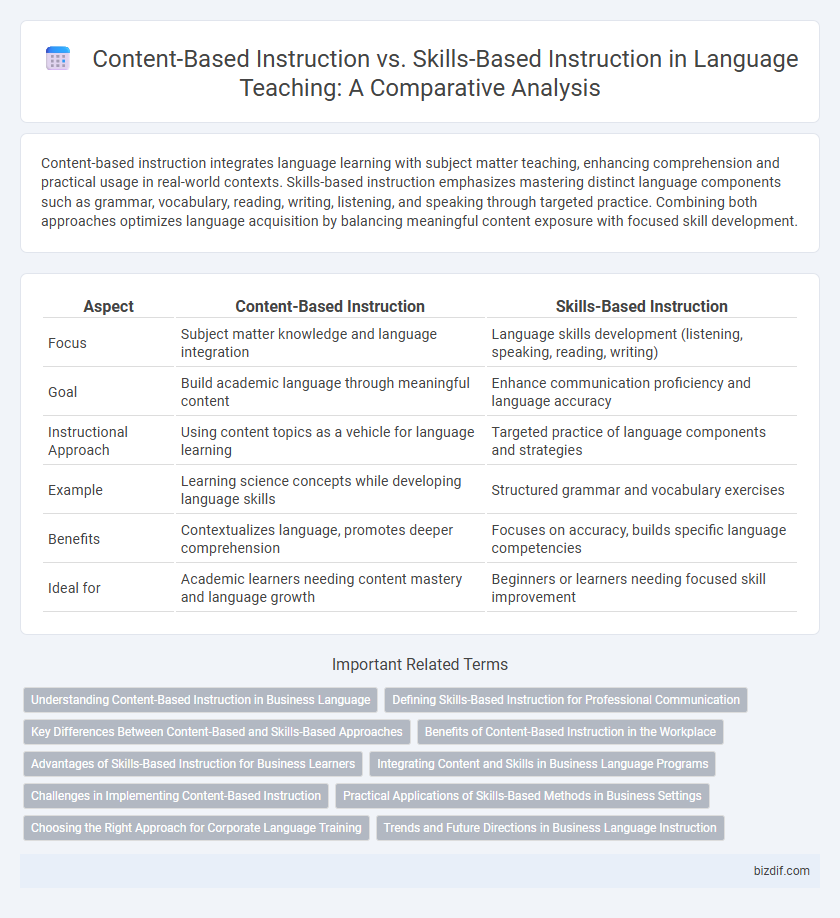Content-based instruction integrates language learning with subject matter teaching, enhancing comprehension and practical usage in real-world contexts. Skills-based instruction emphasizes mastering distinct language components such as grammar, vocabulary, reading, writing, listening, and speaking through targeted practice. Combining both approaches optimizes language acquisition by balancing meaningful content exposure with focused skill development.
Table of Comparison
| Aspect | Content-Based Instruction | Skills-Based Instruction |
|---|---|---|
| Focus | Subject matter knowledge and language integration | Language skills development (listening, speaking, reading, writing) |
| Goal | Build academic language through meaningful content | Enhance communication proficiency and language accuracy |
| Instructional Approach | Using content topics as a vehicle for language learning | Targeted practice of language components and strategies |
| Example | Learning science concepts while developing language skills | Structured grammar and vocabulary exercises |
| Benefits | Contextualizes language, promotes deeper comprehension | Focuses on accuracy, builds specific language competencies |
| Ideal for | Academic learners needing content mastery and language growth | Beginners or learners needing focused skill improvement |
Understanding Content-Based Instruction in Business Language
Content-based instruction in business language prioritizes integrating language learning with relevant industry-specific content, enabling learners to grasp terminology and communication styles essential for real-world business contexts. This approach enhances language proficiency by embedding vocabulary and grammar within meaningful tasks such as negotiations, presentations, and reports, fostering practical application. Unlike skills-based instruction that isolates language components, content-based instruction promotes contextual understanding crucial for effective business communication.
Defining Skills-Based Instruction for Professional Communication
Skills-based instruction for professional communication centers on developing specific competencies such as effective verbal and written communication, active listening, and critical thinking. This approach emphasizes practical application through role-plays, simulations, and targeted exercises that enhance interpersonal and presentation skills in workplace contexts. Assessment focuses on measurable outcomes like clarity, coherence, and appropriateness tailored to professional environments.
Key Differences Between Content-Based and Skills-Based Approaches
Content-based instruction emphasizes learning language through subject matter like science or history, integrating vocabulary and grammar within meaningful topics to enhance comprehension and retention. Skills-based instruction focuses on developing specific linguistic competencies such as listening, speaking, reading, and writing, often through targeted exercises and drills designed to improve proficiency. Key differences lie in content integration versus isolated skill development, with content-based approaches fostering contextual learning and skills-based strategies honing discrete language abilities.
Benefits of Content-Based Instruction in the Workplace
Content-Based Instruction (CBI) enhances workplace language learning by integrating real job-related subjects, which increases learner motivation and engagement through relevant, practical material. This approach improves both language proficiency and subject matter knowledge simultaneously, leading to better job performance and on-the-job communication. Employees benefit from contextualized vocabulary and skills tailored to specific professional environments, making CBI particularly effective for industry-specific training and collaboration.
Advantages of Skills-Based Instruction for Business Learners
Skills-based instruction enhances business learners' practical communication capabilities by emphasizing real-world applications such as negotiation, presentation, and email writing. This method promotes immediate workplace relevance, boosting learners' confidence and efficiency in professional interactions. Focusing on specific language skills aligns directly with business objectives, facilitating measurable improvements in career performance.
Integrating Content and Skills in Business Language Programs
Content-based instruction in business language programs emphasizes subject matter relevant to professional fields, enhancing learners' ability to apply language skills contextually. Skills-based instruction focuses on developing specific language competencies such as speaking, writing, listening, and reading, often in isolation from real-world contexts. Integrating content and skills promotes practical communication by combining business knowledge with targeted language practice, leading to improved fluency and professional effectiveness.
Challenges in Implementing Content-Based Instruction
Implementing content-based instruction (CBI) poses challenges such as aligning language learning objectives with subject matter content, which requires specialized teacher training and interdisciplinary collaboration. Limited resources and materials tailored to both language proficiency and content complexity hinder effective lesson planning and classroom engagement. Furthermore, assessing student progress in CBI demands integrated evaluation tools that address both language skills and content comprehension, complicating standard assessment practices.
Practical Applications of Skills-Based Methods in Business Settings
Skills-based instruction in language learning emphasizes practical communication abilities such as negotiation, presentations, and report writing, directly aligning with real-world business scenarios. This approach enhances employees' functional language competence, enabling more effective interactions in meetings, client relations, and teamwork. Companies benefit from improved workplace communication, increased productivity, and accelerated onboarding for international staff through targeted skills development.
Choosing the Right Approach for Corporate Language Training
Content-based instruction in corporate language training integrates language learning with specific business topics, enhancing practical communication skills directly relevant to the workplace. Skills-based instruction prioritizes fundamental language abilities such as grammar, vocabulary, and pronunciation, building a solid linguistic foundation adaptable to various business contexts. Choosing the right approach depends on corporate goals, employee proficiency levels, and industry-specific language demands to maximize training effectiveness and employee performance.
Trends and Future Directions in Business Language Instruction
Content-based instruction in business language training integrates industry-specific knowledge with language skills, fostering practical communication abilities aligned with real-world business contexts. Skills-based instruction emphasizes mastery of discrete language competencies such as negotiation, presentation, and writing, often through targeted practice and assessment. Emerging trends prioritize hybrid models leveraging digital technologies and authentic materials to enhance learner engagement and align with evolving global business communication demands.
Content-based instruction vs skills-based instruction Infographic

 bizdif.com
bizdif.com